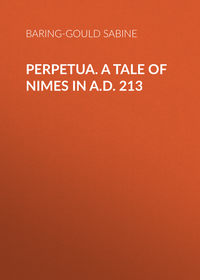 полная версия
полная версияThe Lives of the Saints, Volume 1 (of 16)

S. Baring-Gould
The Lives of the Saints, Volume 1 (of 16)
The Lives of the Saints, which I have begun, is an undertaking, of whose difficulty few can have any idea. Let it be remembered, that there were Saints in every century, for eighteen hundred years; that their Acts are interwoven with the profane history of their times, and that the history, not of one nation only, but of almost every nation under the sun; that the records of these lives are sometimes fragmentary, sometimes mere hints to be culled out of secular history; that authentic records have sometimes suffered interpolation, and that some records are forgeries; that the profane history with which the lives of the Saints is mixed up is often dark and hard to be read; and then some idea may be formed of the difficulty of this undertaking.
After having had to free the Acts of a martyr from a late accretion of fable, and to decide whether the passion took place under – say Decius or Diocletian, Claudius the Elder, or Claudius the younger, – the writer of a hagiology is hurried into Byzantine politics, and has to collect the thread of a saintly confessor's life from the tangle of political and ecclesiastical intrigue, in that chaotic period when emperors rose and fell, and patriarchs succeeded each other with bewildering rapidity. And thence he is, by a step, landed in the romance world of Irish hagiology, where the footing is as insecure as on the dark bogs of the Emerald Isle. Thence he strides into the midst of the wreck of Charlemagne's empire, to gather among the splinters of history a few poor mean notices of those holy ones living then, whose names have survived, but whose acts are all but lost. And then the scene changes, and he treads the cool cloister of a mediæval abbey, to glean materials for a memoir of some peaceful recluse, which may reflect the crystalline purity of the life without being wholly colourless of incident.
And then, maybe, he has to stand in the glare of the great conflagration of the sixteenth century, and mark some pure soul passing unscathed through the fire, like the lamp in Abraham's vision.
That one man can do justice to this task is not to be expected. When Bellarmine heard of the undertaking of Rosweydus, he asked "What is this man's age? does he expect to live two hundred years?" But for the work of the Bollandists, it would have been an impossibility for me to undertake this task. But even with this great storehouse open, the work to be got through is enormous. Bollandus began January with two folios in double columns, close print, of 1200 pages each. As he and his coadjutors proceeded, fresh materials came in, and February occupies three volumes. May swelled into seven folios, September into eight, and October into ten. It was begun in 1643, and the fifty-seventh volume appeared in 1861.
The labour of reading, digesting, and selecting from this library is enormous. With so much material it is hard to decide what to omit, but such a decision must be made, for the two volumes of January have to be crushed into one, not a tenth of the size of one of Bollandus, and the ten volumes for October must suffer compression to an hundredth degree, so as to occupy the same dimensions. I had two courses open to me. One to give a brief outline, bare of incident, of the life of every Saint; the other to diminish the number of lives, and present them to the reader in greater fulness, and with some colour. I have adopted this latter course, but I have omitted no Saint of great historical interest. I have been compelled to put aside a great number of lesser known saintly religious, whose eventless lives flowed uniformly in prayer, vigil, and mortification.
In writing the lives of the Saints, I have used my discretion, also, in relating only those miracles which are most remarkable, either for being fairly well authenticated, or for their intrinsic beauty or quaintness, or because they are often represented in art, and are therefore of interest to the archæologist. That errors in judgment, and historical inaccuracies, have crept into this volume, and may find their way into those that succeed, is, I fear, inevitable. All I can promise is, that I have used my best endeavours to be accurate, having had recourse to all such modern critical works as have been accessible to me, for the determining of dates, and the estimation of authorities.
Believing that in some three thousand and six hundred memoirs of men, many of whose lives closely resembled each other, it would be impossible for me to avoid a monotony of style which would become as tedious to the reader as vexatious to myself, I have occasionally admitted the lives of certain Saints by other writers, thereby giving a little freshness to the book, where there could not fail otherwise to have been aridity; but I have, I believe, in no case, inserted a life by another pen, without verifying the authorities.
At the head of every article the authority for the life is stated, to which the reader is referred for fuller details. The editions of these authorities are not given, as it would have greatly extended the notices, and such information can readily be obtained from that invaluable guide to the historian of the Middle Ages, Potthast: Bibliotheca Historica Medii Ævi, Berlin, 1862; the second part of which is devoted to the Saints.
I have no wish that my work should be regarded as intended to supplant that of Alban Butler. My line is somewhat different from his. He confined his attention to the historical outlines of the saintly lives, and he rarely filled them in with anecdote. Yet it is the little details of a man's life that give it character, and impress themselves on the memory. People forget the age and parentage of S. Gertrude, but they remember the mouse running up her staff.
A priest of the Anglican Church, I have undertaken to write a book which I hope and trust will be welcome to Roman and Anglican Catholics, alike. It would have been unseemly to have carried prejudice, impertinent to have obtruded sectarianism, into a work like this. I have been called to tread holy ground, and kneel in the midst of the great company of the blessed; and the only fitting attitude of the mind for such a place, and such society, is reverence. In reading the miracles recorded of the Saints, of which the number is infinite, the proper spirit to observe is, not doubt, but discrimination. Because much is certainly apocryphal in these accounts, we must not therefore reject what may be true. The present age, in its vehement naturalism, places itself, as it were, outside of the circle of spiritual phenomena, and is as likely to deny the supernatural agency in a marvel, as a mediæval was liable to attribute a natural phenomenon to spiritual causes. In such cases we must consider the evidence and its worth or worthlessness. It may be that, in God's dealings with men, at a time when natural means of cure were unattainable, the supernatural should abound, but that when the science of medicine became perfected, and the natural was rendered available to all, the supernatural should, to some extent, at least, be withdrawn.
Of the Martyrologies referred to, it may be as well to mention the dates of the most important. That of Ado is of the ninth century, Bede's of the eighth;1 there are several bearing the name of S. Jerome, which differ from one another, they are forms of the ancient Roman Martyrology. The Martyrology of Notker (D. 912), of Rabanus Maurus (D. 856), of Usuardus (875), of Wandalbert (circ. 881). The general catalogue of the Saints by Ferrarius was published in 1625, the Martyrology of Maurolycus was composed in 1450, and published 1568. The modern Roman Martyrology is based on that of Usuardus. It is impossible, in the limited space available for a preface, to say all that is necessary on the various Kalendars, and Martyrologies, that exist, also on the mode in which some of the Saints have received apotheosis. Comparatively few Saints have received formal canonization at Rome; popular veneration was regarded as sufficient in the mediæval period, before order and system were introduced; thus there are many obscure Saints, famous in their own localities, and perhaps entered in the kalendar of the diocese, whose claims to their title have never been authoritatively inquired into, and decided upon. There is also great confusion in the monastic kalendars in appropriating titles to those commemorated; here a holy one is called "the Venerable," there "the Blessed," and in another "Saint." With regard also to the estimation of authorities, the notes of genuineness of the Acts of the martyrs, the tests whereby apocryphal lives and interpolations may be detected, I should have been glad to have been able to make observations. But this is a matter which there is not space to enter upon here.
The author cannot dismiss the work without expressing a hope that it may be found to meet a want which he believes has long been felt; for English literature is sadly deficient in the department of hagiology.
Amartyrology means, properly, a list of witnesses. The martyrologies are catalogues in which are to be found the names of the Saints, with the days and places of their deaths, and generally with the distinctive character of their sanctity, and with an historic summary of their lives. The name is incorrect if we use the word "martyr" in its restricted sense as a witness unto death. "Hagiology" would be more suitable, as a martyrology includes the names of many Saints who were not martyrs. But the term "Martyrology" was given to this catalogue at an early age, when it was customary to commemorate only those who were properly martyrs, having suffered death in testimony to their faith; but it is not unsuitable if we regard as martyrs all those who by their lives have testified to the truth, as indeed we are justified in doing.
In the primitive Church it was customary for the Holy Eucharist to be celebrated on the anniversary of the death of a martyr – if possible, on his tomb. Where in one diocese there were several martyrs, as, for instance, in that of Cæsarea, there were many days in the year on which these commemorations were made, and the Church – say that of Cæsarea – drew up a calendar with the days marked on which these festivals occurred.
In his "Church History," Eusebius quotes a letter from the Church of Smyrna, in which, after giving an account of the martyrdom of their bishop, S. Polycarp, the disciple of S. John the Divine, the Smyrnians observe: "Our subtle enemy, the devil, did his utmost that we should not take away the body, as many of us anxiously wished. It was suggested that we should desert our crucified Master, and begin to worship Polycarp. Fools! who knew not that we can never desert Christ, who died for the salvation of all men, nor worship any other. Him we adore as the Son of God; but we show respect to the martyrs, as His disciples and followers. The centurion, therefore, caused the body to be burned; we then gathered his bones, more precious than pearls, and more tried than gold, and buried them. In this place, God willing, we will meet, and celebrate with joy and gladness the birthday of this martyr, as well in memory of those who have been crowned before, as by his example to prepare and strengthen others for the combat."2
S. Polycarp suffered in the year 166; he had been ordained Bishop of Smyrna by S. John in 96. This passage is extremely interesting, for it shows us, in the age following that of the apostles, the Church already keeping the festivals of martyrs, and, as we may conclude from the words of the letter, over the tombs of the martyrs. In this the Church was following the pattern shown to S. John in vision; for he heard the cry of the souls of the martyrs reposing under the altar in heaven. Guided, doubtless, by this, the Church erected altars over the bodies of saints. Among the early Christian writers there are two, S. Paulinus of Nola, and Prudentius, whose testimony is of intrinsic value, not only from its being curiously interesting, but because it is so full and unequivocal as to the fact of the tombs of the martyrs being used as altars.3 In one of his letters to Severus, S. Paulinus encloses some verses of his own composition, which were to be inscribed over the altar under which was deposited the body of S. Clavus, of whom the venerable prelate says:
"Sancta sub æternis altaribus ossa quiescunt."4Before describing the basilica of Nola, the Saint proceeds to give a sketch of another but a smaller church, which he had just erected in the town of Fondi. After furnishing some details about this latter edifice, he says, "The sacred ashes – some of the blessed relics of the apostles and martyrs – shall consecrate this little basilica also in the name of Christ, the Saint of saints, the Martyr of martyrs, and the Lord of lords."5 For this church two inscriptions were composed by Paulinus: one, to accompany the painting with which he had adorned the apse; the other, to announce that portions of the relics of the Apostle S. Andrew, of the Evangelist S. Luke, and of S. Nazarius, and other martyrs, were deposited under the altar. His verses may be thus rendered:
"In royal shrines, with purple marble graced,Their bones are under lighted altars placed.A holy band enshrined in one small chest,Full mighty names within its tiny breast."Prudentius visited not only the more celebrated churches in Spain built over the bodies of the martyrs, he being a Spaniard by birth, but he also visited those of Italy and Rome on a journey made in 405. During his residence in the capital of Christianity, the poet frequented the catacombs; and he has bequeathed to us a valuable record of what he there saw. In his hymn in honour of S. Hippolytus, he tells us that he visited the sepulchral chapel in which were deposited the remains of the martyr; and, after having described the entrance into the cemetery, and the frescoes that adorned it, he adds:
"In gloomy cave the martyr's corpse is placed,And there to God with sacred altars graced,To give the sacrament the board is spread,And zealous guard the holy martyr's bed.The bones are resting in this hallowed tomb,To wait th' eternal Judge's gracious boon;And there with holy food are nourished thoseWho call on Christ where tawny Tiber flows."6In his other hymns, Prudentius bears the most unequivocal testimony to the practice, even then a long time in use, of depositing the relics of the Saints immediately under the altar. It is unnecessary to quote more. The assertions of ancient writers on this point have been several times verified. The bodies of the martyrs have been discovered under the high altars of the churches dedicated to God in their memory. The body of S. Martina, together with those of two other martyrs, SS. Concordens and Epiphanius, were found in 1624 under the high altar of the ancient church near the Roman Forum, which bears the name of the Saint. The body of S. Agnes, and that of another virgin martyr, were also ascertained to be under the high altar of her church, denominated Fuori delle Mura. These, however, had all been removed from the Catacombs into Rome, within the walls.
Now this fact being established, as well as that of the annual commemoration of the Saint reposing in the church, it follows that it became necessary for a Church to draw up calendars marking those days in the year which were consecrated to the memory of martyrs whose relics were preserved in it; for instance, in the Church of Fondi, which contained relics of S. Andrew, S. Luke, S. Nazarius, and others, the Holy Eucharist would be celebrated over the relics on the day of S. Andrew, on that of S. Luke, on that of S. Nazarius, and so on; and it would be necessary for the Church to have a calendar of the days thus set apart.
In the first centuries of the Church, not only the Saints whose bodies reposed in the church, but also the dead of the congregation were commemorated.
When a Roman Consul was elected, on entering on his office he distributed among his friends certain presents, called diptychs. These diptychs were folding tablets of ivory or boxwood, sometimes of silver, connected together by hinges, so that they could be shut or opened like a book. The exterior surface was richly carved, and generally bore a portrait of the Consul who gave them away. Upon the inner surface was written an epistle which accompanied the present, or a panegyric on himself. They were reminders to friends, given much as a Christmas card is now sent. The diptych speedily came into use in the Church. As the Consul on his elevation sent one to his friends to remind them of his exaltation, so, on a death in the congregation, a diptych was sent to the priest as a reminder of the dead who desired the prayers of the faithful. At first, no doubt, there was a pack of these little memorials, each bearing the name of the person who desired to be remembered at the altar. But, for convenience, one double tablet was after a while employed instead of a number, and all the names of those who were to be commemorated were written in this book. From the ancient liturgies we gather that it was the office of the deacon to rehearse aloud, to the people and the priest, this catalogue registered in the public diptychs. In the "Ecclesiastical Hierarchy," attributed to S. Dionysius the Areopagite, but really of a later date, the end of the fifth century, the author says of the ceremonies of the Eucharist, that after the kiss of peace, "When all have reciprocally saluted one another, there is made the mystic recitation of the sacred tablets."7 In the Liturgy of S. Mark we have this, "The deacon reads the diptychs (or catalogue) of the dead. The priest then bowing down prays: To the souls of all these, O Sovereign Lord our God, grant repose in Thy holy tabernacle, in Thy kingdom, bestowing on them the good things promised and prepared by Thee," etc.
It is obvious that after a while the number of names continually swelling would become too great to be recited at once. It became necessary, therefore, to take some names on one day, others on another. And this originated the Necrologium, or catalogue of the dead. The custom of reading the diptychs has ceased to be observed in the Roman Liturgy, though we find it indicated there by the "Oratio supra Diptycha." At present, when the celebrating priest arrives at that part of the Canon called the "Memento," he secretly commemorates those for whose souls he more particularly wishes to pray.
But, in addition to the diptychs of those for whom the priest and congregation were desired to pray, there was the catalogue of the Martyrs and Saints for whom the Church thanked God. For instance, in the modern Roman Mass, in the Canon we have this commemoration: "Joining in communion with, and reverencing, in the first place, the memory of the glorious and ever-virgin Mary, Mother of our God and Lord Jesus Christ; as also of Thy blessed apostles and martyrs, Peter and Paul, Andrew, James, John, Thomas, James, Philip, Bartholomew, Matthew, Simon and Thaddæus; Linus, Cletus, Clement, Xystus, Cornelius, Cyprian, Laurence, Chrysogonus, John and Paul, Cosmas and Damian, and of all Thy Saints," etc. This is obviously a mere fragment of a commemoration of the Blessed Virgin, of the apostles, and then of the special Roman martyrs. The catalogue of the Saints to be remembered was long; there were hundreds of martyrs at Rome alone, and their names were written down on sacred diptychs especially appropriated to this purpose. Such an inscription was equivalent to the present ceremony of canonization. The term canonization itself tells the history of the process. It is derived from that part of the Mass called the Canon, in which occurs that memorial already quoted. On the day when the Pope, after a scrutinizing examination into the sanctity of a servant of God, formally inscribes him among the Saints, he adds his name at the end of those already enumerated in the Canon, after "Cosmas and Damian," and immediately reads Mass, adding this name at this place. Formerly every bishop could and did canonize – that is, add the name of any local Saint or martyr worthy of commemoration in his diocese.
When the list became long, it was found impracticable to commemorate all nominatim at once, and the Saints were named on their special days. Thus, out of one set of diptychs grew the Necrologium, and out of the other the Martyrology.
The Church took pains to collect and commit to writing the acts of the martyrs. This is not to be wondered at; for the martyrs are the heroes of Christianity, and as the world has her historians to record the achievements of the warriors who have gained renown in conflict for power, so the Church had her officers to record the victories that her sons won over the world and Satan. The Saints are the elect children of the spouse of Christ, the precious fruit of her body; they are her crown of glory. And when these dear children quit her to reap their eternal reward, the mother retains precious memorials of them, and holds up their example to her other children to encourage them to follow their glorious traces.
The first to institute an order of scribes to take down the acts of the martyrs was S. Clement, the disciple of S. Peter, as we are told by Pope S. Damasus, in the "Liber Pontificale."8 According to this tradition, S. Clement appointed seven notaries, men of approved character and learning, to collect in the city of Rome, each in his own region of the city, the acts of the martyrs who suffered in it. To add to the guarantee of good faith, Pope S. Fabian9 placed these seven notaries under the control of the seven subdeacons, who with the seven deacons were placed over the fourteen cardinal regions of the city of Rome. Moreover, the Roman Pontiffs obtained the acts of martyrs who had suffered in other churches. These acts were the procès verbal of their trial, with the names of the judges under whom they were sentenced, and an account of the death endured. The acts of S. Philip of Heraclea, SS. Hilary and Tatian, and SS. Peter, Paul, Andrew, and Dionysia, are examples of such acts. Other acts were those written by eye-witnesses, sometimes friends of the martyrs; those of the martyrs, SS. Perpetua, Felicitas, and their companions are instances. The first part of these was written by S. Perpetua herself, and reaches to the eve of her martyrdom; then another confessor in the same prison took the pen and added to the eve of his death, and the whole was concluded by an eye-witness of their passion. Other acts again were written by those who, if not eye-witnesses, were able, from being contemporaries and on the spot, to gather reliable information; such are the narratives of the martyrs of Palestine by Eusebius, Bishop of Cæsarea. Unfortunately, comparatively few of the acts of the martyrs have come down to us in their genuine freshness; and the Church of Rome, which set the example in appointing notaries to record the facts, has been most careless about preserving these records unadulterated; so that even the acts of some of her own bishops and martyrs, S. Alexander, and S. Marcellinus, and S. Callixtus, are romances devoid of all stamp of truth.
Tertullian10 says that on the natal days, that is, on the days of martyrdom of the Saints who have suffered for Christ, "We keep an annual commemoration." It is easy to see how this usage necessitated the drawing up of lists in which were inscribed not only the names of the martyrs, and the place of their decease, but also a few words relative to their conflict, so that the people might associate their names with their victories, and the names might not become, in time, to them empty sounds. S. Cyprian was absent from Carthage when the persecution was raging there, but he wrote to his clergy, "Note the days of their death, that we may celebrate their commemorations along with the memorials of the martyrs."11 S. Augustine says,12 "The Christian people celebrate the memory of the martyrs with religious solemnity, both to excite to imitation, and that they may become fellows in their merits and be assisted by their prayers."
Adrian I. quotes the 13th Canon of the African Church and the 47th of the third Carthaginian Council, in a letter to Charlemagne, in which he says, "The Sacred Canons approved of the passions of the Holy Martyrs being read in Church when their anniversary days were being celebrated."
The names of the martyrs to be commemorated were announced on the eve. By degrees other names besides those of martyrs were introduced into the Martyrologies, as those of faithful servants of God whose lives were deserving of imitation, but who had not suffered to the death in testimony to the truth. Thus we have confessors, or those who endured hardships for Christ, doctors, or teachers of the Church, virgins, widows, bishops and abbots, and even penitents.









